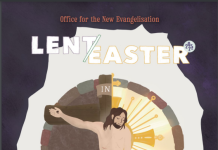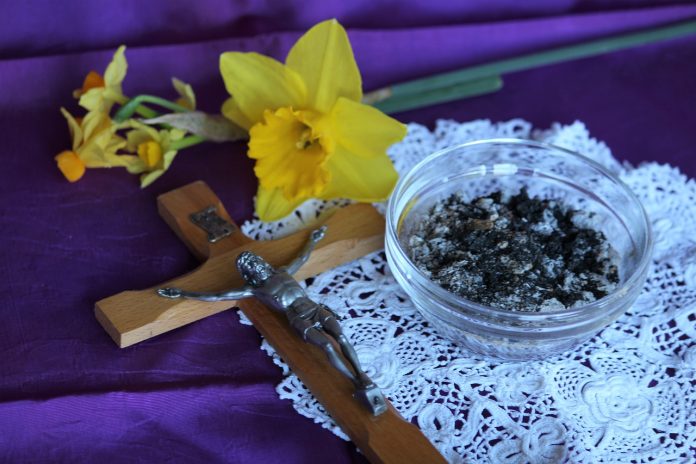By Fr Francis Lim, SJ
Lent begins this year on 2 March with Ash Wednesday. The colour purple is part and parcel of Lent. However, the colour purple is also a colour of paradox. In this article, we explore why the colour purple is used for Lent.
Colour plays an important yet unspoken part of how we relate to things around us. Colour helps to evoke immediate and emotional connection within us with the meaning of an event and its mood. Therefore for this reason, liturgical colours play an important role in the life of Christians, especially Catholics, throughout the year.
Purple, or in some cases, violet, with its deep and almost night-like shade symbolises repentance, penance, abstinence and fasting which are closely associated with Lent. Advent, which can be considered a lesser Lent, also uses purple as its colour for the period of reflective preparation for Christmas.
Royalty versus suffering
Purple was an ancient Mediterranean colour for royalty and luxury taken from a type of shellfish. The original place of extraction was the area of Phoenicia, which literally means “purple land,” especially from a vibrant port city called Tyre. That’s how this dye was also known as Tyrian purple.
It was an expensive dye and luxury trade item because the process of extraction was long and painstaking. It seemed that thousands of molluscs were needed to make just one gram of Tyrian purple. That’s why people who wore purple were generally royalty because they were the only ones who could afford it.
Other than that, Tyrian purple intensified with weathering and wear unlike other textile colours which were plant-based whose lustre faded rapidly. In other words, Tyrian purple was worth both in weight and durability.
Purple was also employed in divine worship. At the time of Moses, purple cloth was used as curtains for the place of the tabernacle together with blue and scarlet colours (cf Ex 26:1). Later when Solomon built the temple in Jerusalem, he followed the design given to Moses and used purple, blue and crimson (a shade of scarlet) fabric as well (cf 2 Ch 3:14).
The reason purple is used for Lent came from the significant event when Pontius Pilate asked that a purple cloak be put onto Jesus during his trial to mock his regal status (cf Jn 19;2; Mk 15:17). It was also carried out by the Roman colonisers to send a strong signal to the Jews against any coup. Ironically this gesture of dressing Jesus in a purple robe was actually indicative of his royal and divine dignity, besides the plaque with the words, “The King of the Jews,” placed on top of the cross.
Consequently in the Church, purple has been identified with the suffering of Jesus, and therefore this royal colour also portrays our repentance and penance. Purple has become a symbol of the offence surrounding our sins. When we look at the colour purple in Lent, we are called to remember what was done for us by Jesus who is a suffering King.
Highest versus lowest
The ancient purple dye was distilled from a mucous gland that lies just behind the rectum of a type of marine snail called Bolinus brandaris, which are commonly found by the shores of the Mediterranean Sea. Molluscs are considered the bottom-feeders of the sea. By extracting this dye from the backside, it only represented the bottom of the bottom-feeders; in other words, the lowest part of one of the lowest creatures of the earth.
To make the Tyrian dye, the snails were collected by the thousands and boiled for days which produced a terrible odour. Though purple may have symbolised a higher order, it reeked of an unpleasant lower odour. Even after dyeing a piece of fabric, the smell persisted for quite a while. Thus, not only does the colour purple have the shade of dark eerie connotations, it has a putrid stench as well.
Kelly Grovier in her article, “Tyrian Purple: The disgusting origins of the colour purple”
(see https://www.bbc.com/culture/article/20180801-tyrian-purple-the-regal-colour-taken-from-mollusc-mucus) calls this purple dye a tension between noxious waste and exalted authority, and between what’s visceral and virtuous. This is apt for an exalted colour that is also used to represent the suffering of Jesus and our own penance; in the lowest part of the ecological chain and also in terms of bad smell!
Bridging the paradox
It is interesting to note that the Gospels of John and Mark mention the purple cloak. The Gospel of Matthew, however, uses the colour scarlet for the robe that was put upon Jesus (cf Mt 27:28) and Luke uses the word, “splendid clothing” (cf Lk 23:11). These two usages are by no means contradictory. Splendid clothing could mean an expensive material, which during the time of Jesus would have been a purple fabric.
For the colour scarlet, we have noted above that scarlet and blue were also used in the Jewish Temple besides purple. Dyes often change shades depending on the dyeing process. Purple can also mean any shade from violet to scarlet, or any colour between blue and red. Hence, the scarlet robe in Matthew could have been a shade of purple, depending on the dyeing process.
Moreover, the tabernacle veil in the Temple separating the Holy of Holies from the rest of the Temple area might have been a combination of purple, blue and scarlet (or crimson or red). Some have interpreted the veil to be of blue on one end and red on the other end. These colours blended in the middle to make purple.
The synoptic Gospels mention that this veil was torn into two from top to bottom at the death of Jesus on the cross (Mt 27:51; Mark 15:38; Luke 23:45). Besides the symbolism of Jesus doing away with the separation of God and humanity with the tearing of the Temple veil which exposed the inner sanctum to the outside world, we can also look at the colour symbolism of the veil. Blue for sky is the colour for divinity, red for the red Judaean hills is the colour for earth or humankind. Purple in the centre of the veil is a blend of blue and red which represents Jesus who is both God and man. By his death, Jesus removed the barrier between heaven and earth, and became the bridge to the Father in the same way purple becomes the link between blue and red.
Indeed, purple is a colour of paradox between worldly might and other-worldly love. God “has brought down the mighty from their thrones and exalted those of humble estate.” (Lk 1:52) During this Lent, let us embrace this tension, and bridge the gap between our privileged status as God’s redeemed saints and our humble penance as sinners.












































